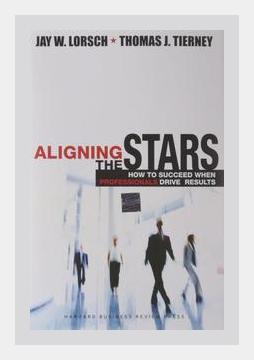Business StrategyStrategic Planning
Introduction
“Aligning the Stars” by Jay W. Lorsch and Thomas J. Tierney is a seminal work on strategic planning specifically tailored to organizations where professionals drive results, such as law firms, consulting practices, and other service-oriented businesses. The book delves into the unique challenges these organizations face and provides actionable insights to help align individual goals with organizational objectives.
Chapter 1: Understanding Professional Service Firms
Key Points:
– Professional service firms (PSFs) rely heavily on human capital.
– The autonomy and expertise of individual professionals are both a strength and a challenge.
Example:
– Law firms depend on the expertise of their lawyers but often struggle with aligning individual goals with the firm’s overall objectives.
Actionable Advice:
– Conduct Individual Goal Alignment Sessions: Schedule regular meetings between management and professionals to discuss individual goals and how they align with organizational targets.
Chapter 2: The Star Model
Key Points:
– The Star Model consists of five significant components: strategy, structure, processes, people, and rewards.
Example:
– A consulting firm implements a new knowledge-sharing system to enhance collaboration but needs to adjust its reward system to incentivize participation.
Actionable Advice:
– Revise Reward Systems: Ensure that rewards and recognition are consistent with desired behaviors, such as collaboration and knowledge sharing.
Chapter 3: Strategy in Professional Service Firms
Key Points:
– Developing a clear strategy is crucial, as it provides a roadmap for all organizational activities.
– Strategies need to focus on areas of competitive advantage.
Example:
– A marketing firm specializes in digital media to differentiate itself from competitors stuck in traditional advertising.
Actionable Advice:
– Develop Specialization Areas: Identify and focus on specific niches or specializations that can offer competitive advantages.
Chapter 4: Organizational Structure
Key Points:
– PSFs often have a matrix structure, where project teams are built around client needs rather than functional hierarchies.
Example:
– A software development firm organizes teams by project, allowing for flexibility and responsiveness to client needs.
Actionable Advice:
– Foster Cross-Functional Teams: Create flexible team structures that can adapt to specific projects and client demands.
Chapter 5: Processes and Systems
Key Points:
– Efficient processes and systems are crucial for effective knowledge management and operational excellence.
Example:
– An engineering consultancy uses a project management software to streamline workflows and improve efficiency.
Actionable Advice:
– Implement Project Management Tools: Adopt tools that help streamline processes and improve project execution.
Chapter 6: Talent Management
Key Points:
– Attracting, developing, and retaining top talent is a critical challenge for PSFs.
– Continuous professional development is essential to maintaining a competitive edge.
Example:
– A legal firm offers continuous education programs to its lawyers to keep them updated on the latest legal developments.
Actionable Advice:
– Invest in Continuous Education: Develop an ongoing professional development program to keep skills relevant and competitive.
Chapter 7: Rewards and Recognition
Key Points:
– Rewards and recognition systems should align with organizational goals and values.
– Non-financial rewards can be as motivating as financial ones.
Example:
– An architecture firm offers sabbaticals as a reward for high performance, enhancing job satisfaction and loyalty.
Actionable Advice:
– Introduce Flexible Rewards: Create a diverse rewards system that includes both financial and non-financial incentives.
Chapter 8: Leadership and Culture
Key Points:
– Leadership plays a crucial role in shaping organizational culture.
– Leaders must exhibit behaviors that reflect the organization’s values and objectives.
Example:
– A financial advisory firm’s leaders consistently engage in ethical behavior, setting a standard for the entire organization.
Actionable Advice:
– Model Desired Behaviors: Leaders should consistently demonstrate behaviors that align with the organization’s core values.
Chapter 9: Client Relationships
Key Points:
– Building strong, long-term client relationships is fundamental to success in professional services.
– Client satisfaction goes beyond delivering quality work; it involves understanding and meeting client needs.
Example:
– An advertising agency conducts regular client satisfaction surveys to tailor services better.
Actionable Advice:
– Conduct Client Surveys: Regularly gather feedback from clients to understand their needs and improve service offerings.
Chapter 10: Adaptability and Innovation
Key Points:
– In a rapidly changing market environment, adaptability and innovation are imperative.
– Encourage a culture that embraces change and continuous improvement.
Example:
– A management consulting firm embraces agile methodologies to respond quickly to market changes.
Actionable Advice:
– Promote a Culture of Innovation: Foster an environment where new ideas are encouraged and implemented.
Conclusion: Integrating the Star Model
Key Points:
– Successful PSFs integrate all components of the Star Model to create a cohesive strategy.
– Alignment across strategy, structure, processes, people, and rewards leads to sustainable success.
Example:
– A healthcare consultancy ensures alignment by regularly reviewing each component of the Star Model and making necessary adjustments.
Actionable Advice:
– Regular Strategic Reviews: Conduct periodic reviews to ensure all aspects of the Star Model are aligned and contributing to overall objectives.
By employing these strategies and principles outlined in “Aligning the Stars,” organizations where professionals drive results can not only enhance individual and organizational performance but also create a sustainable competitive advantage. This book remains a valuable resource for leaders in professional service firms looking to navigate the complexities of strategic planning and aligning their talented workforce to achieve outstanding results.
